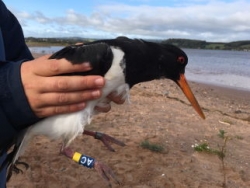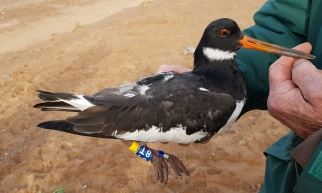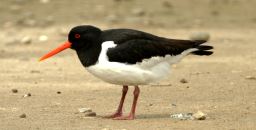Cannon-netting - Dawlish Warren, Saturday 28 September 2019
We got a third successful cannon net catch under our belts at the weekend, we caught 50 Oystercatchers and a Bar-tailed Godwit. Three of the Oystercatchers were already colour-ringed, and we colour ringed the remaining 47.
 Colour-ringed Oystercatcher 'AC'A further 10 adult Oystercatchers were fitted with GPS tags, which is fantastic and will hopefully generate a lot of useful data over the coming winters. We had hoped for a catch of around 200 birds, which would have given us a good chance of catching enough juveniles to be able to GPS tag a sample of this years birds. However, the tide did not reach its expected height which gave the birds other roost options away from the selected catch area, so we did well to take any catch in the circumstances. As we didn’t catch any juveniles, we held back 10 tags to deploy when hopefully we catch some during mist netting sessions.
Colour-ringed Oystercatcher 'AC'A further 10 adult Oystercatchers were fitted with GPS tags, which is fantastic and will hopefully generate a lot of useful data over the coming winters. We had hoped for a catch of around 200 birds, which would have given us a good chance of catching enough juveniles to be able to GPS tag a sample of this years birds. However, the tide did not reach its expected height which gave the birds other roost options away from the selected catch area, so we did well to take any catch in the circumstances. As we didn’t catch any juveniles, we held back 10 tags to deploy when hopefully we catch some during mist netting sessions.
| Species | Ringed | Retraps | Controls | Colour ringed | GPS tagged |
|---|---|---|---|---|---|
| Oystercatcher | 47 | 3 | 0 | 47 | 0 |
Cannon-netting - Dawlish Warren, Monday 12 November 2018
Things didn’t exactly go to plan for the planned cannon net catch on the weekend of 10-11 November. After delaying from the Saturday due to severe weather and a failed fire on Sunday, we reset and assembled a slightly smaller team to try again on Monday.
 Oystercatcher with GPS tagWe did catch 53 Oystercatchers - a reasonable sample of birds - considering there were still problems with the firing system or fuses. All, including an old 'wasp' ringed retrap, were metal ringed and colour-ringed. Most importantly, 10 GPS tags were deployed and birds will be out there now collecting data. A fix on their exact position will be recorded and stored on the tag until it comes into contact with the base station, when it will download all the stored data.
Oystercatcher with GPS tagWe did catch 53 Oystercatchers - a reasonable sample of birds - considering there were still problems with the firing system or fuses. All, including an old 'wasp' ringed retrap, were metal ringed and colour-ringed. Most importantly, 10 GPS tags were deployed and birds will be out there now collecting data. A fix on their exact position will be recorded and stored on the tag until it comes into contact with the base station, when it will download all the stored data.
| Species | Ringed | Retraps | Controls | Colour ringed | GPS tagged |
|---|---|---|---|---|---|
| Oystercatcher | 47 | 5 | 1 | 53 | 10 |
Cannon-netting - Dawlish Warren, Sunday 4 February 2018
On Sunday 4 February 2018, after months of planning a successful catch of 190 oystercatchers took place at Dawlish Warren National Nature Reserve. All birds were aged, weighed, measured and fitted with a uniquely coded metal ring before being safely released. 150 of these birds were also each fitted with a larger uniquely-coded colour ring, which can be read by observers at distance, allowing valuable information to be collected without having to re-catch or disturb the bird.
Oystercatchers are remarkably long-lived birds. Among the birds caught seven of them had previously been ringed at Dawlish Warren, six had been caught before in early 2000s but the oldest was ringed back in 1989, some 28 years ago.
Exactly 150 oystercatchers were fitted with a blue ring engraved in white with a large alpha-numeric code, (e.g. ‘U6’ or ‘2M’) on the right leg, read from the bottom up. Above the blue engraved ring is a plain yellow ring with a metal BTO ring on the left leg. If you see one of these birds, please look out for and note information on date, time, location (precise as possible with a grid reference), and its behaviour (feeding or roosting, in a flock or on its own).
Please send details of sightings of colour-ringed oystercatchers to This email address is being protected from spambots. You need JavaScript enabled to view it..
| Species | Ringed | Retraps | Controls | Colour ringed | GPS tagged |
|---|---|---|---|---|---|
| Oystercatcher | 183 | 7 | 0 | 150 | 0 |
- Latest
- More recent
- 1
- 2
- Older
- Oldest
Project Background
Over recent years the wintering Oystercatcher population has declined significantly in the UK, but this decline has been even greater on the Exe estuary. A number of factors are suspected to be causing this decline, some relate to the estuary, some at larger scales. The colour-ringing project that we are running should help determine what factors are causing the population decline; and to what extent birds from the SPA use the surrounding landscape. The results will help indicate what, if any, actions can undertaken to help reverse declines.
Oystercatchers are faithful to wintering sites so the birds you have seen here years ago may be the same ones now. The oldest Dawlish Warren Oystercatcher on record is at least 36 years old, last seen in Jan 2018.
If you see a bird with one of our colour rings, please use the form on this website to send us the details (ring-code, date, location, species) or you can send email to This email address is being protected from spambots. You need JavaScript enabled to view it..
Cannon netting totals
2017-2018 winter totals
| Species | Ringed | Retraps | Controls | Colour ringed |
|---|---|---|---|---|
| Oystercatcher | 183 | 7 | 0 | 150 |
2018-2019 winter totals
| Species | Ringed | Retraps | Controls | Colour ringed |
|---|---|---|---|---|
| Oystercatcher | 47 | 5 | 1 | 53 |
2019-2020 winter totals
| Species | Ringed | Retraps | Controls | Colour ringed |
|---|---|---|---|---|
| Oystercatcher | 47 | 3 | 0 | 47 |
Grand totals
| Species | Ringed | Retraps | Controls | Colour ringed |
|---|---|---|---|---|
| Oystercatcher | 277 | 15 | 1 | 250 |
